Cleat for Every Line
The
Blue Moon has a lot of lines. To take just the lines that come down the main mast, you have the:
- jib halyard
- foresail halyard
- mainsail peak halyard
- mainsail throat halyard
- mainsail topping lift
- the topsail halyard
- the topsail downhaul
- the topsail outhaul
Then youve got the lines that lead into the cockpit:
- single mainsail sheet
- two jib sheets
- single foresail sheet
- two backstays
- mizzen halyard
- mizzen sheet
Not to mention the lines that terminate on the main or mizzen booms, or on the bowsprit:
- bobstay line
- bobstay tricing line
- mainsail outhaul
- mainsail reefing line
- mizzen lazy jacks
Im probably forgetting a couple lines, but you get the idea. Put that many lines on a 23 boat, and things can get disorganized fast. Not helping matters: there arent enough cleats on the
Blue Moon for all these lines. In fact, when I bought the boat, there were only 5 plastic cleats and 5 belaying pins. That meant that many of those tie-off points had 2 or even 3 lines wrapped around them. Need to get that backstay off quickly? Too bad! First you need to un-cleat the jib and foresail sheets. Have fun with that one!
As part of my no-drama sailing program (more on that, soon), my goal is for each of these lines to have its own dedicated cleat or belaying pin. I might even label them (... no, probably not!)
The point is, when you need to peak up the mainsail, its a heck of a lot easier if (1) you know where its belayed, and (2) the topping lift isnt tied on top of it.
Furthermore, you can imagine how difficult it is for a solo sailor to manage all these lines. A typical tack involves:
- putting the helm over
- half-way through the tack, when the sails are slack:
- tighten the (new) windward backstay
- release the (new) leeward backstay
- release the jib sheet
- heave in the opposite jib sheet
- breath again
To make tacking easier, all the lines that need to be handled during a tack should really be on quick-release jam cleats, rather than tied to a traditional horn cleat. The main sheet, for safetys sake, should also be on a jam cleat.
Ive already built one cleat -- a boom cleat for the mainsail outhaul -- so I have a bit of experience with this... not a lot, but enough to get me going.
For my first jam cleat, I chose a pattern for what I believe is a Butler Cleat... a jam cleat designed by the famous 19th century canoeist, Paul Butler. Im still trying to track down a definitive source for this pattern, but heres the pattern that I have:
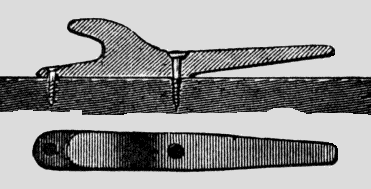 |
| Butler Cleat |
I just Photoshopped this image into the size cleat I wanted, printed it out, and cut the side profile out with scissors. Just like in kindergarten.
Then I just layer it on a piece of scrap oak and traced around it with a pencil. This is no-drama building, so I didnt go crazy with this.
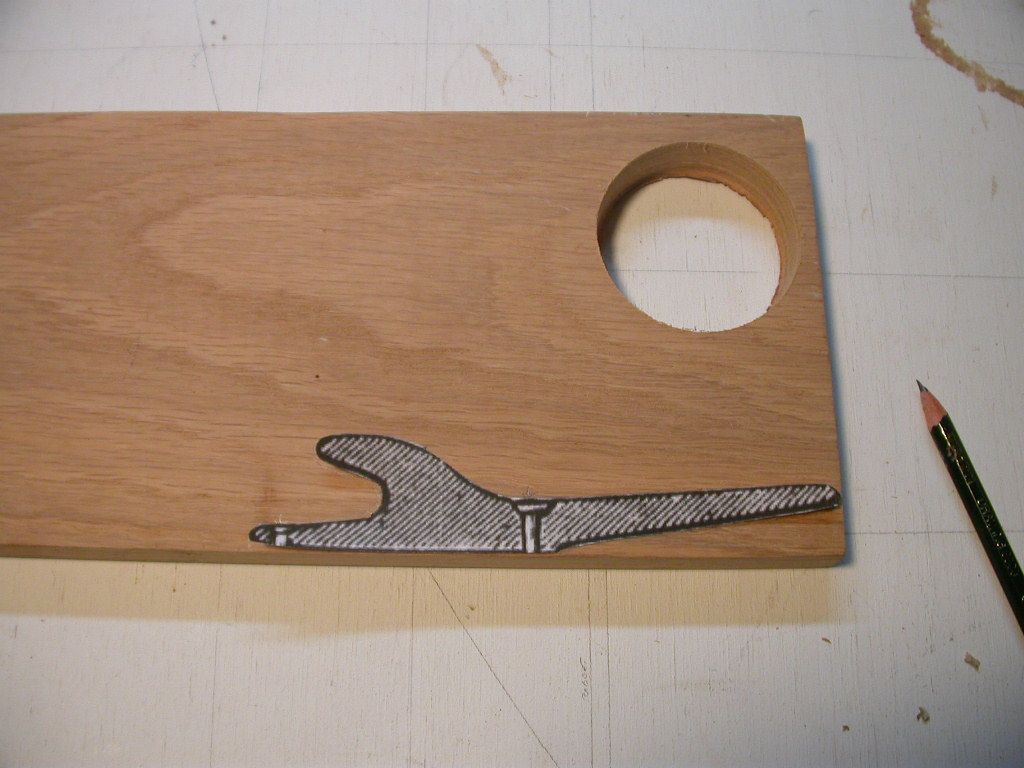 |
| Template on scrap of Oak |
Then I roughly cut out the piece with a 1/8" blade on my new 2-wheel bandsaw. I scored this beauty on Craigslist last week, from an octogenarian whos "downsizing" his woodworking shop. With its solid construction, decent rollers, and powerful belt-drive motor, its a huge step up from my old Buffalo 3-wheeler, and the price was unbeatable. Just goes to show that you can get some amazing tools for next to nothing if you are patient enough.
 |
| New Bandsaw! |
The saw came with a box full of brand new blades (some with "Merry Christmas, grandpa!" labels still attached), so I installed a 1/8" blade, and used it to roughly cut out the cleat. Total time, maybe 5 minutes.
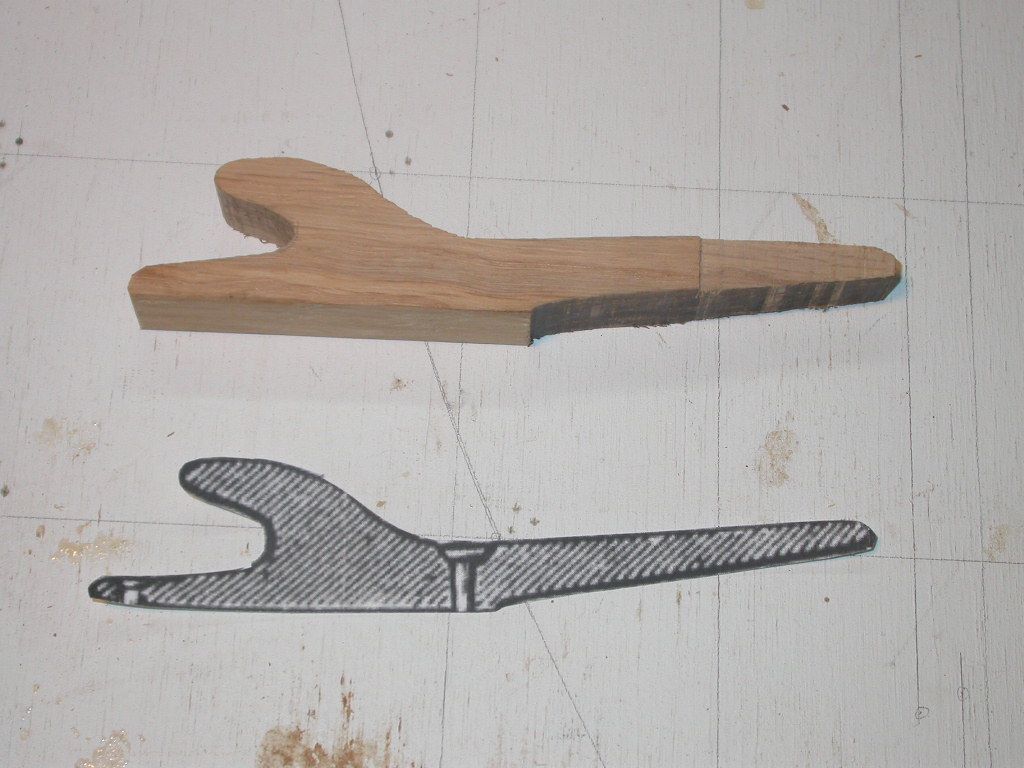 |
| Roughly cut out |
Then I quickly shaped it with some 60 grit sandpaper, used my cheese-grater style rasp to round the curve around the tall horn, and finished it off with 120 grit sandpaper.
Again, maybe 10 minutes.
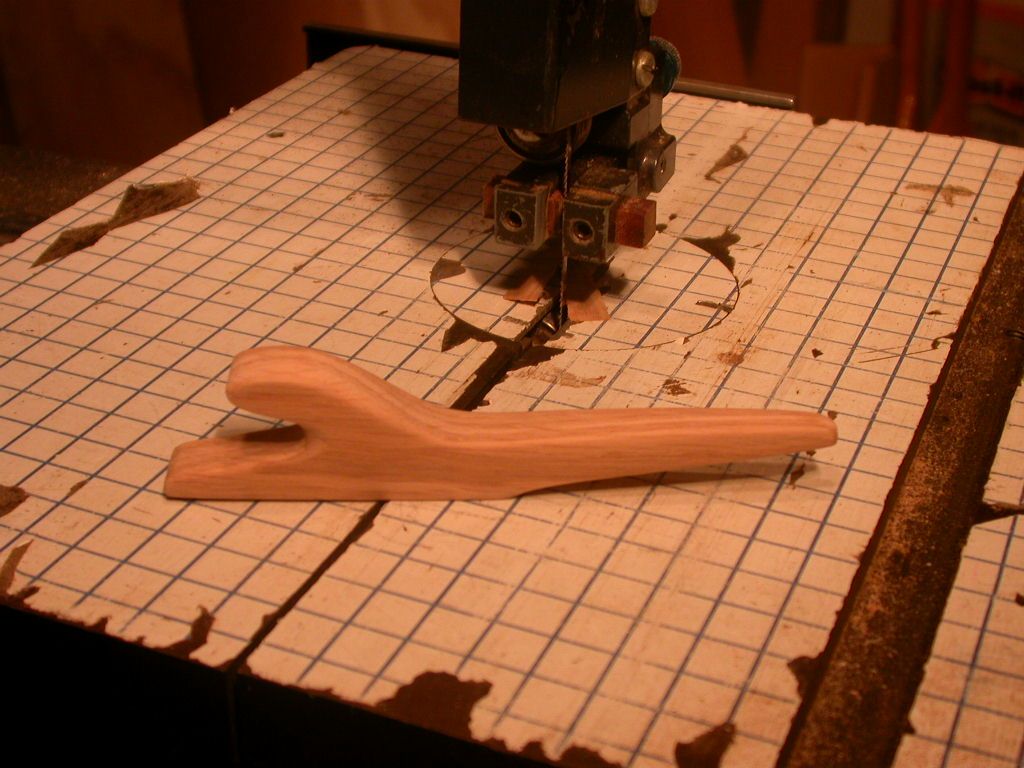 |
| After a bit of sanding |
The only trouble I had was drilling the lower screw hole... the one on the left on the template. My countersink bit is a bit too large in diameter, so to get past the horn, I had to drill the hole a bit close to the back end of the cleat. Next time, Ill just cut the base a bit longer, to allow more room for the screw. 1/4" should do it.
Since this was literally the first jam cleat Id every actually seen, I really wasnt exactly sure how it would work. I wasnt even sure which direction it should point, or wether the rope should pass through the jamming side first, or after going around the horn side first.
I had my theories, but I wanted to test them out before installing the cleat. So I screwed it down to a piece of scrap wood and played around with it for a bit.
Pretty obviously, the line should pass around the horn, first, then through the jammer. I also discovered it worked great with lines from 5/16" or 3/8" line. For my 1/2" main sheet, Id probably want to scale it up a bit.
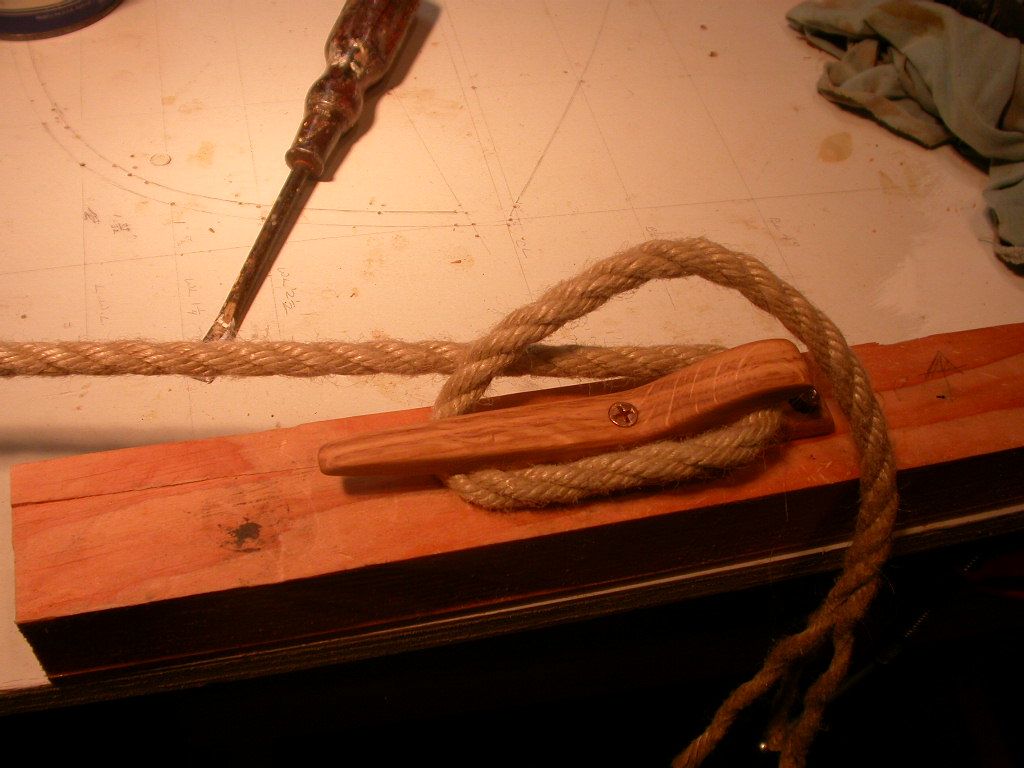 |
| Testing in shop |
With the testing done, it was time to install it on the
Blue Moon, but first, I wanted to give it a bit of protection. The cleat is finished with a coat of linseed oil, followed by a good rubbing of my home-brew paste wax, made from linseed oil and beeswax. Im hoping this wax will lend more protection than linseed oil alone. Linseed oil is great for a table in your living room, but useless on a boat. It just doesnt last long enough. Only time will tell if wax is any better. Ill let you know.
 |
| Paste-wax and bronze screws |
Here it is, bedded down with Dolphinite, and screwed in with 1 1/2" bronze screws. Im using this one for my foresail sheet. The pull of the line is all to the left, and screws are very strong against that sort of sheer force, so I think they will be strong enough. If there was any lifting force, Id want to through-bolt them.
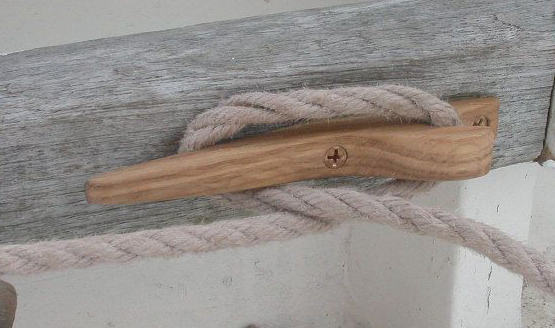 |
| Installed and working! |
Anyway, my son Chris and I took the cleat out for a shake-down cruise this weekend, and it performed magnificently. Im going to build several more of various sizes for the rest of my quick-release lines.
It was a real joy to complete a project in one easy evening. The old timers designed cleats in all sorts of different specialized shapes, but none of them look hard to make. If youre looking for a quick and cheap way to improve your boat, building strong, good looking wood cleats is a great option.
And if you use scrap wood, theyre practically free! What more could you ask for?
If this inspires you to build any, please send photos and Ill post them to a future blog.
>>> Next Episode: Helena Gets a Notion








No comments:
Post a Comment